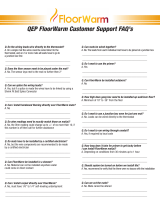
Problem
Mat resistance measurement is
outside the range printed on the
nameplate label.
Floor is not getting warm.
Floor heats continuously.
Control is not working correctly.
Control is not working at all.
GFCI conflicts and false-trips.
Possible Cause
An analog ohmmeter (using a moving needle)
was used to take the reading.
If measurement shows an open or short circuit,
the heating wire has been damaged.
If measurement is just a little low or high, room
temperature has affected the resistance.
The mat may be wired in series or “daisy
chained” with another mat, or may be wired in
parallel with another mat. Either will provide
false resistance readings.
Mat heating wire has been damaged.
GFCI has tripped, indicated by a light on the
control and GFCI on display
Incorrect voltage supplied, or mismatched
electrical components used.
Mats are wired in “series” or “daisy chained”
(end-to-end).
Floor sensor is loose or broken or control is set
on “AIR” sense.
Incorrect wiring. The control was “bypassed”
when it was wired to the power supply.
Defective control.
If a programmable control, the programming
may be incorrect.
Incorrect voltage supplied, or mismatched
components used.
Floor sensor is not wired properly, or is not
working properly.
Loose connection(s) on line side and/or load
side of control.
No power is supplied.
Floor sensor is not wired properly, or is not
working properly.
Defective control.
More than one GFCI on the circuit.
Loose wiring connection(s).
An electric motor or a ballasted light source is
sharing the circuit with the control.
Solution
Obtain a digital ohmmeter able to read 0 to 20,000 ohms and remeasure the resistance.
Record resistance between all wires and contact the manufacturer.
Make the room temperature 75°–85°F, or contact the manufacturer.
Make sure resistance measurements are for only one mat at a time. Disconnect any other mats.
Measure mat resistance. Check for both “open circuit” and “short circuit” as detailed earlier in this
manual. If damaged, record resistances between all wires and contact the manufacturer.
Check for loose wire connections. Reset the GFCI on the control or circuit breaker. If it trips again,
check for a short circuit in the mat as detailed earlier in this manual. If mat is damaged, record
resistance between all wires and contact the manufacturer. If mat is not damaged, replace the
GFCI control. Also see “GFCI conflicts” below.
Measure “line” voltage, then measure “load” voltage.
Multiple mats must be connected in “parallel” (or black-to-black, white-to-white).
Pull the sensor wires loose from the control and reinsert them. If this does not solve the problem,
loosen the sensor wires from the control and measure resistance across the sensor wires. For a
SunTouch control sensor the resistance should be between 17,000 ohms (at 55°F/13°C) and 8,000
ohms (at 85°F/29°C). See sensor wire resistance values on page 6. Turn circuit breaker off then on
to reset the SunStat.
Make sure wiring connections are correct. Consult the wiring diagram on the back of the control,
the instructions that came with the control, or the wiring diagrams in Part 6 of this manual to
make sure the four connections are correct.
Return control to dealer for replacement.
Carefully read and follow control programming instructions.
Measure voltage at the control and make sure it matches the control voltage rating, and the mat
voltage rating. Make sure electrical components are compatible.
Make sure only one floor sensor is connected to the control. Also see “Sensor is loose or
broken” above. Turn circuit breaker off then on to reset the SunStat.
Remove and reinstall the wire nuts at each connection. Make sure the wire nuts are tight.
Check all connections back to the breaker.
Check circuit breaker. Measure voltage at the control. Check all connections between breaker
and control.
The control can only read the signal from a single floor sensor. Make sure only one floor sensor is
connected to the control. Also see “Sensor is loose or broken” above.
Return control to dealer for replacement.
GFCI units will sometimes trip when there is nothing wrong with the equipment on the circuit,
but when there is more than one GFCI on the same circuit. Reroute power to avoid having more
than one GFCI on the circuit.
Remove and reinstall the wire nuts at each connection. Make sure the wire nuts are tight.
Check all connections back to the breaker.
Electric motors and other electrical devices can cause a GFCI to false-trip. Run a dedicated circuit
to the floor-warming system.
If problems arise with the SunTouch
UnderFloor mat or its related electri-
cal components, please consult this
troubleshooting guide. If not qualified to
perform electrical work, it is highly recom-
mended that a qualified, licensed electri-
cian be hired.
Any electrical troubleshooting work
should be performed with the power
removed from the circuit, unless other-
wise noted.
Although this troubleshooting guide
is provided to assist with problems expe-
rienced with a SunTouch floor-warming
system, results are never guaranteed.
SunTouch does not assume any liability
or responsibility for damage or injury that
may occur from using this guide.
If problems with the system persist,
call the manufacturer at 888-432-8932.
PART 7: Troubleshooting Guide
4500 E. Progress Place
Springfield, MO 65803-8816
888-432-8932 (toll-free phone)
417-522-6128 (phone)
417-831-4067 (fax)
www.suntouch.com/diy
Certain electric floor heating components, systems, and devices shown in this document
are patented under foreign and U.S. patents including numbers 6,303,905, 6,300,598, and
5,908,573. Trademarks and U.S. Registered Trademarks and copyrighted material herein
are the property of Watts Radiant, Inc. and/or client.
Electric Radiant Floor Warming













